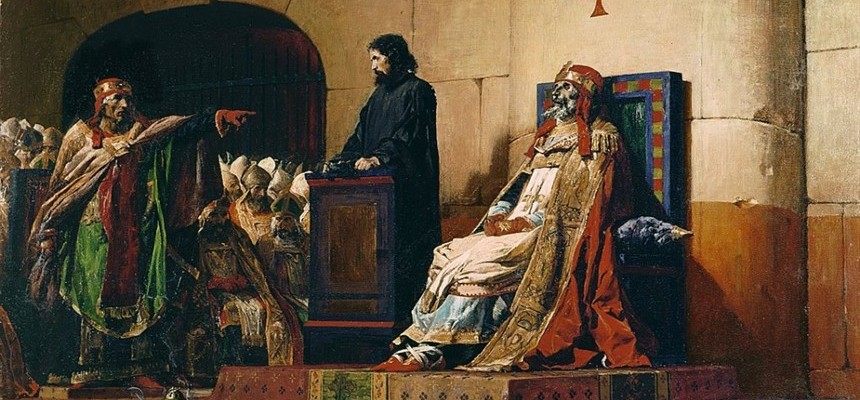
We last left Pope Formosus in a desperate situation. He had been pressed into crowning young Lambert, son of Duke Guy of Spoleto, emperor. But within a short period, Formosus turned to King Arnulf, of East Francia and disputed King of Italy, and crowned him emperor. This effectively would eliminate the rule of Emperor Lambert. The young emperor was driven out of Rome as Arnulf approached, but, arriving home to Spoleto, he found enemies there, too. Arnulf was crowned as the new emperor on 2/22/896. After two weeks, spent organizing his officials, Arnulf headed north towards Spoleto, 126 km away. Before he could arrive, Arnulf suffered a debilitating stroke. He could not attack. The army took him back to Bavaria where he stayed for three years before dying. Lambert took advantage of the situation by having his minions go through the countryside rounding up Arnulf’s officials and imprisoning or killing them. He quickly took over central Italy.
In the meantime, Formosus died on April 4. Some say he died of gout and some say he was thrown in prison by Arnulf’s troops and beaten. This would imply that Formosus was not a supporter of Arnulf. We may never know the truth. But almost immediately after his death, riots began, possibly instigated by the Spoletans fighting the Arnulf supporters for control of Rome. Remember, the government of Rome was essentially ruled by the pope.
Possibly to quell the riots, the elderly priest Boniface, son of a Bishop Adrian, was elected. As a native of Rome, this could have been a popularity win. However, this selection was not liked by the powers. He lasted two weeks. Some say he died of gout in that two-week period. Others say that he was ejected and/or killed to make way for a candidate of the Spoletan party. It looks like “gout” may have been an easy keyword for murder, since so many died of the “gout” at that time.
Two years after Boniface’s brief reign, in 898, a synod, lead by Pope John IX, pronounced the election of Boniface null and void. The reasoning was that Boniface seemed to suffer from “unworthy conduct”, in his past. There were two instances of his being sentenced to deprivation of orders, once as a subdeacon and once as a priest. Since there was no record of his being canonically reinstated, he did not qualify to be a pope. Although his election was negated, he was not removed from the listings as 112th pope.
In his place was elected Stephen VI, whose reign began May 22, 896. He was a priest of no known talents, related to the family running Spoleto at the time. He had been consecrated a bishop by Formosus a few years before. Taking over another bishopric was illegal at the time. So, technically, he couldn’t be pope. But his family had a way around that. The emperor and his mother came back to Rome in January, 897, and insisted on a synod. Interestingly, there was an earthquake that month that did much damage to the Lateran Palace and much of Rome.
In an abjectly disgusting display, the cadaver of the former pope Formosus, was disinterred, dressed in papal vestments and enthroned. A trial was held, where some poor deacon had to hide behind the throne and respond for the dead man. By the end of the day, the disgusted clergy ended up negating all actions Formosus had achieved during his reign, including ordinations and consecrations. The cadaver was stripped of his finery, three fingers of his right hand severed and buried in a potters’ grave. That, in turn was dug up and thrown in the Tiber. And, that, in turn, was rescued and reburied.
Stephen was, then, free to be pope, since his bishop consecration was nullified. His good luck did not hold. The disgust with which the public held his destruction of honor of a pope finally showed itself and he was deposed and jailed. Very quickly, the next pope, Romanus, reversed all the rulings of the so-called Cadaver Synod, putting Formosus back in his once-revered place. Then he had Stephen strangled in August of 897.

Recent Comments